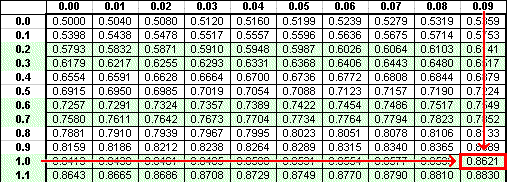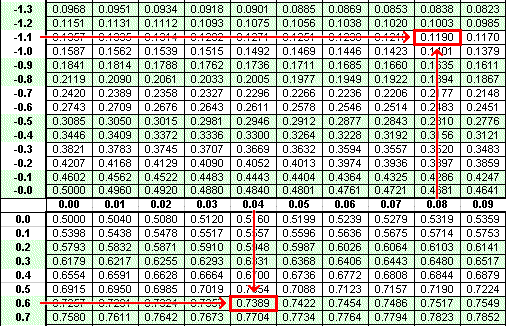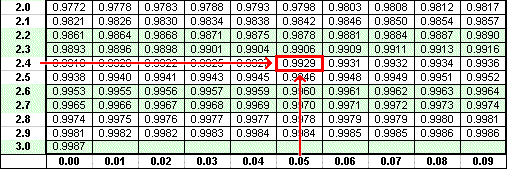

Suppose the reaction times of teenage drivers are normally distributed with a mean of 0.53 seconds and a standard deviation of 0.11 seconds.
The goal is to find P(x < 0.65).
1. The first step is to convert 0.65 to a standard score.
z = (x - mean) / standard deviation = (0.65 - 0.53) / 0.11 = 1.09
2. The problem now is to find P(z < 1.09). This is a left tail problem as shown in the illustration to the right.
P(z < 1.09) = 0.8621 (see table below)
Therefore, P(x < 0.65) = 0.8621

The goal is to find P(0.4 < x < 0.6).
1. The first step is to convert 0.4 and 0.6 to the corresponding standard scores.
z1 = (x - mean) / standard deviation = (0.4 - 0.53) / 0.11 = -1.18
z2 = (x - mean) / standard deviation = (0.6 - 0.53) / 0.11 = 0.64
2. The problem now is to find P(-1.18 < z < 0.64). This is a "between" problem as shown in the illustration to the right.
P(-1.18 < z < 0.64)
= P(z < 0.64) - P(z < -1.18)
= 0.7389 - 0.1190 (see table below)
= 0.6199Therefore, P(0.4 < x < 0.6) = 0.6199

The problem is to find P(x > 0.8).
1. The first step is to find the corresponding standard score.
z = (x - mean) / standard deviation = (0.8 - 0.53) / 0.11 = 2.45
2. The problem now is to find P(z > 2.45). This is a right tail problem as shown in the illustration to the right.
P(z > 2.45)
= 1 - P(z < 2.45)
= 1 - 0.9929 (see table below)
= 0.0071Therefore, P(x > 0.8) = 0.0071

Suppose the chest sizes of 19th century Scottish Militiamen are normally distributed with a mean of 39.83 inches and a standard deviation of 2.05 inches.
The problem is to find P(x < 36).
1. First, convert 36 to a standard score.
z = (x - mean) / standard deviation = (36 - 39.83) / 2.05 = -1.87
2. Find P(z < -1.87). This is a left-tail problem as shown in the illustration to the right.
P(z < -1.87) = 0.0307 (see table below)
Therefore, P(x < 36) = 0.0307 = 3.07%

Find P(40 <= x <= 44).
1. First, convert 40 and 44 to the corresponding standard scores.
z1 = (x - mean) / standard deviation = (40 - 39.83) / 2.05 = 0.08
z2 = (x - mean) / standard deviation = (44 - 39.83) / 2.05 = 2.03
2. Find P(0.08 <= z <= 2.03). This is a "between" problem as shown in the illustration to the right.
P(0.08 <= z <= 2.03)
= P(z <= 2.03) - P(z <= 0.08)
= 0.9788 - 0.5319 (see table below)
= 0.4469Therefore, P(40 <= x <= 44) = 0.4469 = 44.69%

Find P(x >= 38)?
1. First, convert 38 to a standard score.
z = (x - mean) / standard deviation = (38 - 39.83) / 2.05 = -0.89
2. Find P(z >= -0.89). This is a right-tail problem as shown in the illustration to the right.
P(z >= -0.89)
= 1 - P(z <= -0.89)
= 1 - 0.1867 (see table below)
= 0.8133Therefore, P(x >= 37) = 0.8133 = 81.33%
